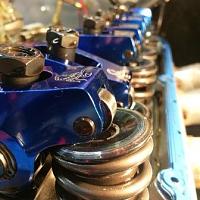Quote:
Originally Posted by CHP2RA

Front left cylinder exhaust valve has dropped past the valve keepers & spring retainer. No compression in this cylinder. The valve keepers remain in place; see attached photo: the keepers are there, but the valve has dropped. How does this happen? My mechanic is puzzled. Any thoughts or suggestions are appreciated. The tear-down continues.
Roush 402R, 8,500 miles, Tremec TKO-500, Superformance MK III roadster SPO 2650.
 |
Certainly the head has to come off when it does you will quickly find the culprit.
If the keepers are still in place in the retainer there are two obvious possibilities;
Possibility 1
The keepers were not hardened steel and the spring rate was high enough to shear the retaining land(s) off the keeper allowing the valve to slip through. This usually results in PTV contact and a bent valve along with a valve seat that needs to be repaired.
If this is what has happened to you you need to replace all the remaining locks before you experience a repeat failure on a different valve. While this is a possible explanation of your failure, Possibilities 2 & 3 are more likely.
Possibility 2
That valve was experiencing valve float. The reasons for valve float range from operating the engine at a speed the spring could no longer control the valve at, to a spring that was installed incorrectly. Incorrect spring installation would include too low a seat pressure, too many shims that caused the spring to stack solid during operation and the rocker to force the valve through soft steel locks or the aluminum retainer (more on that in a bit).
Because your engine is a Roush and I suspect no one has rebuilt it from the as delivered Roush condition my suspicion would be mild steel multi groove keepers, possibly a low seating pressure for the spring, more (but not normally excessive) rpm than the low seat pressure spring could properly control valve motion at, and repeated operation in this rpm range.
The result of that sort of problem would be the eventual failure of the valve lock and the valve pushing through the locks allowing the spring to relax as you have experienced.
Possibility 3
If the keepers and the valve are both undamaged then there is a third possibility. The third possibility is the valve locks and the valve performed properly but the retainer failed allowing the the locks and valve to push through.
This sort of failure is usually caused by a spring that had insufficient seat pressure and or spring rate. During operation the spring can not control the valve motion and the opening ramp on the cam causes the rocker to slap or if you will hammer the stem of the valve because the valve is not where it is supposed to be.
The repeated hammering by the rocker drives the valve stem / valve lock combination through the aluminum retainer like a nail through a 2x4.
Bottom Line
You have some Sherlock Homes detective work laid out in front of you. Take your time be observant and you will find it is one of those three possibilities that has laid waste to that valve/valve spring assembly. Correct the problem and you should be good to go.
In the FWIW category aluminum retainers on the street look cool (when the valve covers are off) but add nothing to the reliability of the valve train. Even when you do not have the sort of carnage you are experiencing the steel spring is always abrading away against the underside of the retainer.
There are many sources of good quality steel racing retainers today. It would be to your advantage to invest in some. You will be surprised to discover they weigh about the same as aluminum because they can use thinner cross sections and achieve the same strength with steel.
If you do periodic Blackstone Labs
oil analyses you will find the aluminum from the steel springs abrading against the aluminum retainers prominently reading in their analysis. Eventually the abrasion will bring an unhappy event — that doesn't need to happen.
Ed
p.s. I don't know what type of valves Roush specs in their engines. Regardless of whether they are single groove valve stems or multi groove valve stems your locks need to be hardened steel. The multi groove valve stems were designed to allow the valve to rotate in service providing better service life.
The single groove valve stems were designed for racing to prevent the type of failure you have just experienced. They will grab the valve stem incredibly tightly preventing the valve from rotating. They also will prevent the valve from escaping the locks. They do all of this at the price of not rotating the valve in service.
For a race engine the single lock solution is the cat's meow. For a non race application the multi groove valve stem with hardened steel multi groove locks is the answer. Irregardless of valve stem lock style you want to be using hardened steel locks — and I would encourage you to explore steel racing retainers.